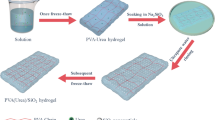Abstract
In our study, the mechanical properties and degradability of vascular grafts made from poly(ε-caprolactone) (PCL) and poly(lactic-co-glycolic acid) (PLGA) at different ratios were investigated. The results showed that the electrospun PCL/PLGA grafts possess good mechanical properties and biodegradability. The tensile and burst strength of the scaffolds met the demands of vascular grafts. In vitro degradation tests indicated that the degradation rate of the materials increased with the percentage of PLGA, and in vivo tests showed that increasing the amount of PLGA is an effective way to promote cell infiltration. Particularly, the electrospun PCL/PLGA blended scaffold with 10% PLGA exhibited a balance of mechanical and degradation properties, making it a promising tissue engineering material for vascular grafts.






Similar content being viewed by others
References
Allen RA, Wu W, Yao MY et al (2014) Nerve regeneration and elastin formation within poly (glycerol sebacate)-based synthetic arterial grafts one-year post-implantation in a rat model. Biomaterials 35(1):165–173
Kong XY, Han BQ, Li H et al (2012) New biodegradable small-diameter artificial vascular prosthesis: a feasibility study. J Biomed Mater Res, Part A 100A(6):1494–1504
Zhang KH, Yin AL, Huang C et al (2011) Degradation of electrospun SF/P(LLA-CL) blended nanofibrous scaffolds in vitro. Polym Degrad Stabil 96(12):2266–2275
Discher DE, Janmey P, Wang YL (2005) Tissue cells feel and respond to the stiffness of their substrate. Science 310(5751):1139–1143
Wu W, Allen RA, Wang YD (2012) Fast-degrading elastomer enables rapid remodeling of a cell-free synthetic graft into a neoartery. Nat Med 18(7):1148–1153
Li L, Terry CM, Shiu Y et al (2008) Neointimal hyperplasia associated with synthetic hemodialysis grafts. Kedney International 74(10):1247–1261
Murugan R, Ramakrishna S (2007) Design strategies of tissue engineering scaffolds with controlled fiber orientation. Tissue Eng 13(8):1845–1866
Kidoaki S, Kwon IK, Matsuda T (2005) Mesoscopic spatial designs of nano- and microfiber meshes for tissue-engineering matrix and scaffold based on newly devised multilayering and mixing electrospinning techniques. Biomaterials 26(1):37–46
Ye SH, Hong Y, Sakaguchi H et al (2014) Nonthrombogenic, biodegradable elastomeric polyurethanes with variable sulfobetaine content. ACS Appl Mater Interfaces 6(24):22796–22806
Jin GZ, Park JH, Lee EJ et al (2014) Utilizing PCL microcarriers for high-purity isolation of primary endothelial cells for tissue engineering. Tissue Engineering Part C-Methods 20(9):761–768
Wang ZH, Cui Y, Wang JN et al (2014) The effect of thick fibers and large pores of electrospun poly(epsilon-caprolactone) vascular grafts on macrophage polarization and arterial regeneration. Biomaterials 35(22):5700–5710
An J, Wang K, Chen SY et al (2015) Biodegradability, cellular compatibility and cell infiltration of poly (3-hydroxybutyrate-co-4-hydroxybutyrate) in comparison with poly (ε-caprolactone) and poly(lactide-co-glycolide). Journal of Bioactive and Compatible Polymers 30(2):209–221
Tang ZG, Callaghan JT, Hunt JA (2005) The physical properties and response of osteoblasts to solution cast films of PLGA doped polycaprolactone. Biomaterials 26(33):6618–6624
Sun HF, Mei L, Song CX et al (2006) The in vivo degradation, absorption and excretion of PCL-based implant. Biomaterials 27:1735–1740
De Valence S, Tille JC, Mugnai D et al (2012) Long term performance of polycaprolactone vascular grafts in a rat abdominal aorta replacement model. Biomaterials 33(1):38–47
Han FX, Jia XL, Dai DD et al (2013) Performance of a multilayered small-diameter vascular scaffold dual-loaded with VEGF and PDGF. Biomaterials 34(30):7302–7313
Milleret V, Hefti T, Hall H et al (2012) Influence of the fiber diameter and surface roughness of electrospun vascular grafts on blood activation. Acta Biomater 8(12):4349–4356
Kona S, Dong JF, Liu YL et al (2012) Biodegradable nanoparticles mimicking platelet binding as a targeted and controlled drug delivery system. International Journal of Pharmaceutics 423(2):516–524
Nguyen TH, Lee BT (2010) Electro-spinning of PLGA/PCL blends for tissue engineering and their biocompatibility. Journal of Materials Science-Materials in Medicine 21(6):1969–1978
Hu J, Sun X, Ma HY et al (2010) Porous nanofibrous PLLA scaffolds for vascular tissue engineering. Biomaterials 31(31):7971–7977
Hong JH, Jeon HJ, Yoo JH et al (2007) Synthesis and characterization of biodegradable poly(epsilon-caprolactone-co-beta-butyrolactone)-based polyurethane. Polym Degrad Stab 92(7):1186–1192
Subramanian A, Krishnan UM, Sethuraman S (2012) Fabrication, characterization and in vitro evaluation of aligned PLGA-PCL nanofibers for neural regeneration. Ann Biomed Eng 40(10):2098–2110
Deitzel JM, Kleinmeyer J, Harris D et al (2001) The effect of processing variables on the morphology of electrospun nanofibers and textiles. Polymer 42(1):261–272
Kim JY, Cho DW (2009) Blended PCL/PLGA scaffold fabrication using multi-head deposition system. Microelectron Eng 86(4–6):1447–1450
Sell SA, McClure MJ, Barnes CP et al (2006) Electrospun polydioxanone-elastin blends: potential for bioresorbable vascular grafts. Biomed Mater 1(2):72–80
Yamada H, Evans FG (1970) Strength of biological materials. Williams & Wilkins, Baltimore
Konig G, McAllister TN, Dusserre N et al (2009) Mechanical properties of completely autologous human tissue engineered blood vessels compared to human saphenous vein and mammary artery. Biomaterials 30(8):1542–1550
Versypt ANF, Pack DW, Braatz RD (2013) Mathematical modeling of drug delivery from autocatalytically degradable PLGA microspheres - A review. J Control Release 165(1):29–37
LeBlon CE, Pai R, Fodor CR et al (2013) In vitro comparative biodegradation analysis of salt-leached porous polymer scaffolds. J Appl Polym Sci 128(5):2701–2712
Gorrasi G, Pantani R (2013) Effect of PLA grades and morphologies on hydrolytic degradation at composting temperature: assessment of structural modification and kinetic parameters. Polym Degrad Stab 98(5):1006–1014
Castilla-Cortázar I, Más-Estellés J, Meseguer-Dueñas JM et al (2012) Hydrolytic and enzymatic degradation of a poly (ε-caprolactone) network. Polym Degrad Stab 97(8):1241–1248
Yang LQ, Li JX, Meng S et al (2014) The in vitro and in vivo degradation behavior of poly (trimethylene carbonate-co-ε-caprolactone) implants. Polymer 55(20):5111–5124
Acknowledgements
This work is supported by National Key Research and Development Program of China (No. 2017YFC1103500), National Natural Science Foundation of China (No. 81671842), and Natural Science Foundation of Tianjin, China (No. 16JCZDJC37600).
Author information
Authors and Affiliations
Corresponding author
Rights and permissions
About this article
Cite this article
Gao, J., Chen, S., Tang, D. et al. Mechanical Properties and Degradability of Electrospun PCL/PLGA Blended Scaffolds as Vascular Grafts. Trans. Tianjin Univ. 25, 152–160 (2019). https://doi.org/10.1007/s12209-018-0152-8
Received:
Revised:
Accepted:
Published:
Issue Date:
DOI: https://doi.org/10.1007/s12209-018-0152-8




